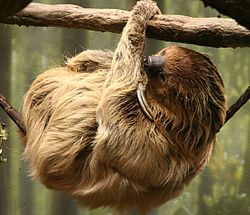Two-toed sloth
| Two-toed sloths | |
|---|---|
 |
|
| Linnaeus's two-toed sloth (Choloepus didactylus) | |
| Scientific classification | |
| Kingdom: | Animalia |
| Phylum: | Chordata |
| Class: | Mammalia |
| Superorder: | Xenarthra |
| Order: | Pilosa |
| Suborder: | Folivora |
| Family: | Megalonychidae |
| Genus: |
Choloepus Linnaeus, 1758 |
| Species | |
Choloepus is a genus of mammals of Central and South America, within the family Megalonychidae consisting of two-toed sloths. The two species of Choloepus (which means "lame foot"), Linnaeus's two-toed sloth (Choloepus didactylus) and Hoffmann's two-toed sloth (Choloepus hoffmanni), are the only surviving members of the family Megalonychidae.
A study of retrovirus and suggests that C. didactylus and C. hoffmani diverged six to seven million years ago. Furthermore, based on sequences, a similar divergence date (~ 7 Ma) between the two populations of C. hofmanni separated by the Andes has been reported.
Although similar to the somewhat smaller and generally slower-moving three-toed sloths (Bradypus), the relationship between the two genera is not close. Recent phylogenetic analyses support analysis of morphological data from the 1970s and 1980s, suggesting the two genera are not closely related and each adopted its arboreal lifestyle independently. It is unclear from which, if any, ground-dwelling sloth taxa the three-toed sloths evolved; the two-toed sloths appear to nest phylogenetically within one of the divisions of Caribbean megalonychids, and thus probably either descended from them or are part of a clade that invaded the Caribbean multiple times. Though data has been collected on over 33 different species of sloths just by analyzing bone structures, many of the relationships between clades on a phylogenetic tree are unknown. Both types tend to occupy the same forests; in most areas, a particular species of three-toed sloth and a single species of the larger two-toed type will jointly predominate.
Each genus of sloth has a common ancestor, but what that ancestor was, when it existed, and many of its traits remain virtually unknown. There is relatively little evidence to support the hypothesis of diphyly and only a small amount of data to study overall. In fact, most of the evidence to support the hypothesis of diphyly is still heavily based on the same trait that cause the hypothesis to be suggested; the structure of the inner ear.
...
Wikipedia
